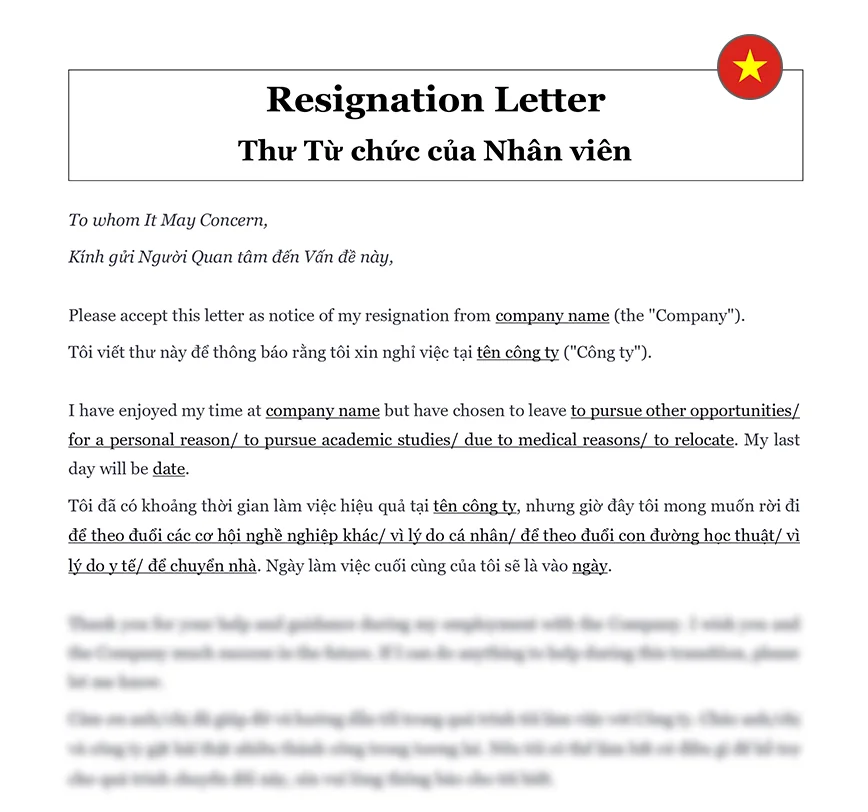Ready to use legal template
Work on without any hassle
Vietnamese-English translation
Ready to use legal template
Work on without any hassle
Vietnamese-English translation
Learn more about Employee Resignation Letter in Vietnam
An Employee Resignation Letter serves as a crucial document in this process, formally communicating an individual’s decision to leave their current position. At Themis Partner, we understand the importance of clarity and legality in such matters. Our meticulously crafted Employee Resignation Letter template, drafted by seasoned legal professionals, ensures compliance with Vietnamese employment laws. Delivered in an easily editable Word format, our template empowers individuals to articulate their resignation with precision and professionalism.
Table of contents
What is an Employee Resignation Letter?
What is included in an Employee Resignation Letter?
Why is it important to submit a formal resignation letter?
What are the rules about Employee Resignation Letters in Vietnam?
How to submit an Employee Resignation Letter in Vietnam?
What are the steps to take after submitting my resignation letter?
Can I rescind or retract my resignation letter in Vietnam?
What is an Employee Resignation Letter?
An Employee Resignation Letter is a formal correspondence penned by an employee to inform their employer of their decision to leave their current position within the company. This document serves as a professional means of communicating the intent to resign and provides essential details such as the anticipated last day of work and any additional information deemed relevant. By adhering to standard business formatting and language, this letter ensures clarity and professionalism in the resignation process, fostering a smooth transition for both the departing employee and the employer.
Crafting an Employee Resignation Letter is a crucial step in the employment departure process, facilitating transparency and professionalism between the departing employee and their employer. It serves as a formal record of the resignation, helping to manage expectations and responsibilities during the transition period. Additionally, a well-written resignation letter reflects positively on the departing employee, leaving a lasting impression of professionalism and integrity as they move forward in their career journey.
What is included in an Employee Resignation Letter?
An Employee Resignation Letter typically includes several key components:
Date: The date when the letter is written.
Recipient Information: The name and title of the person to whom the letter is addressed, usually the immediate supervisor or HR department.
Statement of Resignation: A clear statement indicating the employee’s intention to resign from their position.
Last Working Day: The specific date on which the employee intends for their resignation to take effect, usually providing at least two weeks’ notice as a professional courtesy.
Reason for Resignation (Optional): While not always necessary, some employees may choose to include a brief explanation for their decision to resign. This could be for personal reasons, career advancement, or other opportunities.
Appreciation: Expressing gratitude for the opportunities and experiences gained during the tenure with the company.
Offer of Assistance: An offer to assist with the transition process, such as training a replacement or completing outstanding tasks.
Contact Information: Providing contact details in case further communication is needed during the transition period.
Why is it important to submit a formal resignation letter?
Submitting a formal resignation letter is crucial as it serves as an official record of an employee’s intent to leave the company. This formal documentation ensures that there is a clear and unambiguous record of the resignation, including important details such as the employee’s last working day. It helps prevent misunderstandings or disputes regarding the resignation date, notice period, and any remaining responsibilities. Additionally, a resignation letter demonstrates professionalism and respect towards the employer, reflecting well on the departing employee and maintaining positive relations, which can be beneficial for future references or networking opportunities.
Furthermore, a formal resignation letter provides an opportunity for the employee to express gratitude for the experiences and opportunities provided by the employer. This gesture of appreciation can help leave a positive impression and ensure that the transition is as smooth as possible for both parties. For the employer, receiving a formal resignation letter allows for proper planning and management of the transition, including initiating the process of finding a replacement and redistributing tasks among current employees. This helps ensure continuity in operations and minimizes disruptions to the workflow.
What are the rules about Employee Resignation Letters in Vietnam?
In Vietnam, while there are no specific laws dictating the format or content of resignation letters, there are general practices and regulations that employees and employers typically follow:
| ➤ Notice Period: According to Vietnamese labor laws, employees are generally required to provide advance notice to their employer before resigning. The standard notice period is usually 30 days for indefinite-term labor contracts and shorter for fixed-term contracts, as stipulated in the labor contract or company regulations. Failure to provide proper notice may result in financial penalties or other consequences. |
| ➤ Formality: Resignation letters are expected to be written in a professional and respectful manner. While there's no strict format, it's customary to address the letter to the employer or HR department and include essential details such as the intended last working day. |
| ➤ Documentation: It's advisable for both the employee and employer to keep a copy of the resignation letter for their records. This serves as documentation of the resignation process and can help resolve any disputes or misunderstandings that may arise later. |
| ➤ Exit Procedures: Employees are typically expected to complete any necessary exit procedures outlined by the employer, such as returning company property or completing handover tasks before their departure. |




